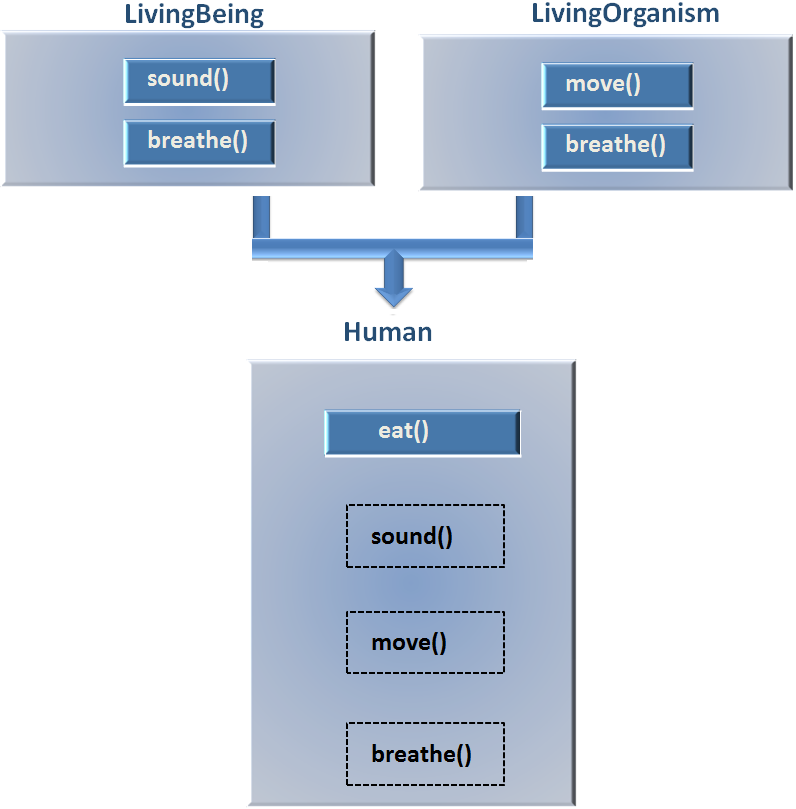

We have seen that a Child class can have a Parent class. But as a matter of fact, a Child class can have Multiple Parent Classes.
Let us clarify with the below example.

So, every other Gods who creates say, Fish, Bird, Human must inherit the 'LivingBeing' and 'LivingOrganism'.
Now, let us create the 'Human' class and inherit both the classes'LivingBeing' and 'LivingOrganism'.
class LivingBeing:
def sound(self):
print("Make a sound to communicate")
def breathe(self):
print("Breathes oxygen from Air")
class LivingOrganism:
def move(self):
print("Everyone should move")
def breathe(self):
print("Breathes oxygen from Air")
class Human(LivingBeing, LivingOrganism):
def eat(self):
print("Eats to survive")
human1 = Human()
human1.eat()
human1.move()
human1.breathe()
So, we have defined the 'LivingBeing' class.
class LivingBeing:
def sound(self):
print("Make a sound to communicate")
def breathe(self):
print("Breathes oxygen from Air")
And defined the 'sound( )' and 'breathe( )' method in it.
Also, we have defined the 'LivingBeing' class.
class LivingOrganism:
def move(self):
print("Everyone should move")
def breathe(self):
print("Breathes oxygen from Air")
And defined the 'move( )' and 'breathe( )' method in it.
Now, if you see the 'breathe( )' method of 'LivingOrganism' class. It is specially designed for 'Fish' class. As the print statement says, 'Breathes oxygen from Air'.
def breathe(self):
print("Breathes oxygen from Air")
Then we have defined the 'Human' class, inheriting the 'LivingBeing' and 'LivingOrganism'.
class Human(LivingBeing, LivingOrganism):
def eat(self):
print("Eats to survive")
And the 'Human' class has just one method, i.e. 'eat( )'.
So, by inheritance. 'Human' class will have all the methods of 'LivingBeing' and 'LivingOrganism' class.

Then we have created the 'human1' object.
And called the 'eat( )' and 'move( )' method.
Then when we try calling the 'breathe( )' method, which 'breathe( )' method actually gets called?
Since, both the classes 'LivingBeing' and 'LivingOrganism' has the 'breathe( )' method. It becomes a confusion that which 'breathe( )' method gets called?
Now, if we look at the output,
The 'breathe( )' method of 'LivingBeing' gets called. And to understand why ? Let us look at MRO or Method Resolution Order.
So, in the above scenario the 'Human' class has two Parents. i.e. 'LivingBeing' and 'LivingOrganism'.And both 'LivingBeing' and 'LivingOrganism' has a method called 'breathe( )'.
Now to decide, which 'breathe( )' method would be called. Python follows a methodology called as Method Resolution Order or MRO.
Which says, if there are multiple parents, i.e. 'LivingBeing' and 'LivingOrganism'. Methods of 'LivingBeing' class would be called first as it is mentioned first in the 'Human' class.

And since, the 'LivingBeing' is the first one, so the 'breathe( )' method gets called first,ignoring the 'breathe( )' method of the 'LivingOrganism' class.
As we have seen in the previous tutorial that the 'super( )' Function is used in the child class to call a method of its Parent class.
Let us see, how it works with Multiple Inheritance.
class Supreme:
def __init__(self):
print("In the Supreme class")
class LivingBeing(Supreme):
def __init__(self):
print("In the LivingBeing class")
super().__init__()
class LivingOrganism(Supreme):
def __init__(self):
print("In the LivingOrganism class")
super().__init__()
class Human(LivingBeing, LivingOrganism):
def __init__(self):
print("In the Human class")
super().__init__()
human1 = Human()
So, in the above example, we have created called 'Supreme'.
class Supreme:
def __init__(self):
print("In the Supreme class")
Then we have created the 'LivingBeing' and 'LivingOrganism' class and inherited the 'Supreme' class in both 'LivingBeing' and 'LivingOrganism' class.
class LivingBeing(Supreme):
def __init__(self):
print("In the LivingBeing class")
super().__init__()
class LivingOrganism(Supreme):
def __init__(self):
print("In the LivingOrganism class")
super().__init__()
And we have the 'Human' class that inherits from 'LivingBeing' and 'LivingOrganism' class.
class Human(LivingBeing, LivingOrganism):
def __init__(self):
print("In the Human class")
super().__init__()

Now, when we create the 'human1' Object.
So, the '__init__( )' constructor of 'Human' class gets called first.
Now, in the '__init__( )' constructor of 'Human' class, a call to '__init__( )' is made using the 'super( )' Function.
def __init__(self):
print("In the Human class")
super().__init__()
And as per the, Method Resolution Order or MRO the '__init__( )' constructor of 'LivingBeing' gets called first.
def __init__(self):
print("In the LivingBeing class")
super().__init__()
Then once again, a call to '__init__( )' is made using the 'super( )' Function. And the '__init__( )' constructor of 'LivingOrganism' gets called second.
def __init__(self):
print("In the LivingOrganism class")
super().__init__()
And finally, 'super( ).__init__( )' calls the '__init__( )' constructor of 'Supreme' class.
And if you see the final output.
You can see, 'Human' class gets called first, then 'LivingBeing' class, then 'LivingOrganism' class and finally, the Supreme class gets called.